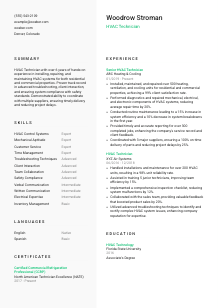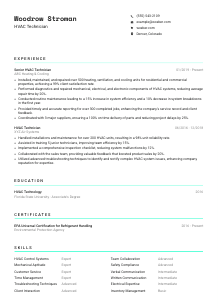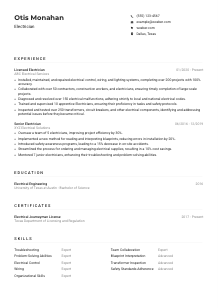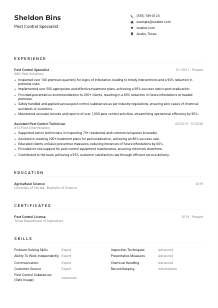HVAC Technician Resume Example
Mastering HVAC works, but your resume blows hot and cold? Dial in on this HVAC Technician resume example, orchestrated with Wozber free resume builder. Learn how to fine-tune your HVAC expertise to harmonize with job criteria, setting your career's airflow to ultimate comfort!

How to write a HVAC Technician resume?
Hello, future HVAC Technician superstar! Are you ready to heat up your job search and cool down your competition? In the high-stakes world of HVAC Technician job hunting, your resume is your most trusted tool. Think of it as your personal toolkit, finely calibrated to match the needs of your target job.
With the Wozber free resume builder at your side, this guide will navigate you through the process of crafting an ATS-compliant resume that not only meets the job description but exceeds expectations. Let's turn up the thermostat on your career!
Personal Details
Laying down the foundation of your resume starts with the Personal Details section. It might seem straightforward, but it's in these details that your first impression is made. For an HVAC Technician position, aligning your personal information with job specifics is a breeze when you have the right tools. Let's dive into enhancing this section.
1. Showcase Your Name Loud and Proud
Your name is not just a label, it's your brand. Make sure it stands out by choosing a clear, professional font. Bold it or consider a slightly larger font size to ensure it catches the eye. After all, you want your name to be memorable.
2. Position Title Under Your Name
Directly below your name, mirror the job title you're applying for - in this case, 'HVAC Technician.' This small but powerful tactic aligns you with the job from the get-go and helps ATS recognize your candidacy as relevant.
3. Essential Contact Info Only
Keep your contact information simple yet complete. Include your most reliable phone number and a professional email address (stick to the firstname.lastname format if possible). Make sure these details are error-free. You don't want a typo standing between you and your next opportunity.
4. Address: A Subtle Nod to Job Location
Mentioniing 'Denver, Colorado,' subtly aligns you with the core requirement of being local. It's an easy win that tells employers, "I'm here and ready to work." Remember, small details can have a big impact on your resume's effectiveness.
5. Web Presence: Only If Relevant
If you have a LinkedIn profile or professional website, include it, but ensure it's scrubbed for consistency with your resume. This means updated job history, skills, and any endorsements or testimonials that speak to your HVAC expertise.
Takeaway
Crafting the perfect Personal Details section is like wiring up a thermostat: it sets the temperature for the rest of your resume. Pay attention to detail, keep it professional, and align with the job's requirements. This section is your first handshake with the employer, make sure it's a firm one.





Experience
Where the rubber meets the road, or should we say, where the tools meet the unit! The Experience section is your chance to shine a light on your professional journey as an HVAC Technician. Highlighting your hands-on experience and aligning it with specific job requirements is key to crafting a compelling narrative.
- Installed, maintained, and repaired over 500 heating, ventilation, and cooling units for residential and commercial properties, achieving a 99% client satisfaction rate.
- Performed diagnostics and repaired mechanical, electrical, and electronic components of HVAC systems, reducing average repair time by 20%.
- Conducted routine maintenance leading to a 15% increase in system efficiency and a 10% decrease in system breakdowns in the first year.
- Provided timely and accurate reporting for over 300 completed jobs, enhancing the company's service record and client feedback.
- Coordinated with 3 major suppliers, ensuring a 100% on‑time delivery of parts and reducing project delays by 25%.
- Handled installations and maintenance for over 200 HVAC units, resulting in a 98% unit reliability rate.
- Assisted in training 5 junior technicians, improving team efficiency by 15%.
- Implemented a comprehensive inspection checklist, reducing system malfunctions by 12%.
- Collaborated with the sales team, providing valuable feedback that boosted product sales by 20%.
- Utilized advanced troubleshooting techniques to identify and rectify complex HVAC system issues, enhancing company reputation for expertise.
1. Analyze Job Requirements
Carefully dissect the job description. For an HVAC Technician, keywords like 'install, maintain, repair heating, ventilation, and cooling units' and 'perform diagnostics' are golden. These are the experiences you want to highlight.
2. Structure Your Roles
Lead with your most recent role, clearly stating your job title, the company's name, and your tenure there. This chronological layout gives hiring managers a clear view of your journey up the HVAC ladder.
3. Highlight Achievements
Go beyond listing duties. Highlight specific accomplishments, like 'Reduced average repair time by 20%' or 'Achieved a 99% client satisfaction rate.' Such stats not only illustrate your capabilities but also your impact.
4. Quantify Your Impact
Whenever possible, backs your achievements with numbers. Did you increase system efficiency? By how much? Numbers make your contributions tangible and more impressive.
5. Relevance is Key
If it doesn't relate directly to the role of an HVAC Technician or the skills listed in the job description, leave it out. Focus on what makes you a perfect fit for the job in question.
Takeaway
Your experience section is your main stage. It's where you perform, showcasing your technical brilliance and professionalism. Each bullet point is an opportunity to capture the hiring manager's attention. Make each one count by aligning closely with the job requirements and demonstrating the value you bring.
Education
Even in the hands-on world of HVAC, your education packs a punch. It's not just about where you've been, but about the foundation of knowledge you've built. Showing off your education in relation to the HVAC Technician position is straightforward when you stick to the point and highlight what matters most.
1. Match the Job's Educational Requirements
The job description didn't specify educational requirements, but listing your Associate's Degree in HVAC Technology positions you well. It shows formal training in the field, backing up your hands-on experience.
2. Keep it Clear and Simple
List your degree, the field of study, and your alma mater. If you've graduated within the last five years, including the graduation year is helpful; otherwise, it's optional. The goal is clarity and relevance.
3. Precision Over Volume
Your HVAC Technology degree is directly relevant, making it the highlight of this section. There's no need to list every seminar or short course unless they add significant value or cover niche areas of the HVAC field.
4. Relevant Courses, If Applicable
For newer technicians or those without extensive experience, listing critical coursework can beef up your resume. If you've completed advanced refrigeration courses or specialized in energy-efficient systems, make that known.
5. Other Educational Honors
If your academic journey includes accolades that showcase your commitment and prowess in the HVAC field, like a relevant research project or technology innovation award, include them. They offer a broader picture of your capabilities and interests.
Takeaway
Your education section anchors your technical aptitude and commitment to the HVAC field. Highlight your relevant degrees, tout any honors, and don't underestimate the power of specialized training or coursework. It's all about building a solid foundation that reassures employers you're both technically adept and constantly learning.
Certificates
In the HVAC world, certifications are like the high-efficiency seal on a top-of-the-line unit – they matter. Certifications prove your skills are current and that you take your profession seriously. Let's rev up the compressor and dive into how to spotlight these credentials.
1. Key Certificates to Highlight
An EPA Universal Certification is like gold in the HVAC industry; it's non-negotiable. Echo it prominently as it directly satisfies a major job requirement. Also, highlight the Certified Commercial Refrigeration Professional (CCRP) for that extra edge.
2. Quality Over Quantity
Not every certificate you've earned needs to be on your resume. Focus on those that align with this role's responsibilities and demands. It's about showcasing depth in areas that matter for this specific job.
3. Dates Matter
For every certificate, include the date of attainment or renewal. It's vital as it shows that your credentials are current, underscoring your commitment to staying updated in a fast-evolving field.
4. Continuous Improvement
The HVAC field is always advancing, and so should you. Seek out further certifications that bolster your expertise, especially those emphasizing emerging technologies or energy efficiency trends. This proactive approach speaks volumes to potential employers.
Takeaway
Your certificates are badges of honor, showcasing your expertise and dedication. Include them strategically, ensuring they align with the job's needs and spotlight your continuous commitment to professional growth. They're not just credentials; they're proof you're at the top of your game.
Skills
The Skills section is your HVAC system's control panel – it symbolizes the core of your capabilities. Fine-tuning this section to mirror the job description precisely can significantly boost your resume's efficacy. Let's ensure you're dialed in on the right frequency.
1. Extract Key Skills
Begin by mining the job description for specific skills. 'HVAC control systems,' 'troubleshooting techniques,' and 'safety compliance' are skills that match your experience. Including them signals you're in tune with what the job requires.
2. Mirror Job Description Skills
Your skill set should reflect the job's needs like a well-matched capacitance. List your proficiencies in mechanical aptitude, customer service, and any other skills directly mentioned in the job posting. This ATS-friendly tactic increases your resume's match rate.
3. Organize and Prioritize
While it's tempting to list every skill you possess, focus on the ones most pertinent to the job at hand. Prioritize those that directly respond to the job description, ensuring your resume is both precise and concise.
Takeaway
Your Skills section is the heart of your professional identity on paper. It's critical to refine it to a razor-sharp edge, ensuring every skill listed powerfully resonates with the job's specifics. This is not just about showing you're qualified; it's about proving you're the best fit.
Languages
While not the main condenser in the HVAC Technician's toolkit, linguistic abilities can increase your marketability, especially in diverse settings. Let's ensure your language skills don't get lost in the ductwork but instead add an extra layer of appeal to your resume.
1. Match Job Language Requirements
The job calls for 'Competency in English.' List your proficiency as 'Native' if applicable, demonstrating you meet this fundamental requirement. Your command of English is crucial for both technical documentation and customer interactions.
2. Additional Languages: A Plus
Understand that while not explicitly required, knowing another language like Spanish (especially in certain regions) can be a distinguishing asset. It shows you're prepared for a broader range of customer interactions.
3. Be Honest About Your Level
Accuracy in representing your language proficiency is key. Use terms like 'Native,' 'Fluent,' 'Intermediate,' and 'Basic' to clarify your level. This honesty helps set realistic expectations and showcases your integrity.
4. Languages and Global Perspectives
Even if not directly required, additional languages might come in handy for companies with a broader, perhaps even global, client base. They illustrate your versatility and readiness to engage with diverse populations.
5. Role-Focused Language Skills
For an HVAC Technician, the ability to communicate effectively with clients in their language can significantly enhance customer satisfaction and service quality. Consider the role's scope and how your linguistic skills can add value.
Takeaway
Your multilingual abilities can be the cool breeze that sets you apart in a stack of resumes. Highlighting these skills demonstrates not only your communication prowess but also your cultural competence, enhancing your overall profile. Remember, in a world that's more connected than ever, every language you speak is a key to a new door.
Summary
Imagine your resume summary as the thermostat of your application - it sets the temperature for how your resume is received. A well-crafted summary for an HVAC Technician not only encapsulates your experience and skills but also preps the reader for the detailed excellence to follow. Let's create a compelling opening statement.
1. Absorb the Job's Core Needs
Firstly, understand what the job is really about. The role's essence lies in 'installing, maintaining, and repairing HVAC systems.' Your summary must reflect your prowess and years of experience in these areas.
2. Captivating Opening
Begin with an assertive introduction. 'HVAC Technician with over 6 years of hands-on experience' immediately establishes your credentials and grabs attention.
3. Match and Highlight
Mirror key job requirements by mentioning your EPA Universal Certification and your success in reducing repair times and increasing system efficiency. This specific alignment shows you're not just any candidate; you're the right fit.
4. Conciseness is Key
Your summary should be a powerful punch of your biggest achievements and skills - all in 3-5 lines. Think of it as your elevator pitch; make every word count.
Takeaway
Your summary is the handshake that invites hiring managers to read further. It captures your suitability for the HVAC Technician role in a nutshell, showcasing both your technical prowess and professional accomplishments.
Launching Your HVAC Technician Journey
Congratulations, you've made it through the blueprint of constructing a standout HVAC Technician resume with Wozber. Armed with these insights and the power of our free resume builder, including the ATS-friendly resume templates and ATS resume scanner, you're now ready to draft a resume that doesn't just pass the test but sets the bar. Remember, your resume is more than a piece of paper; it's a reflection of your professional journey and a beacon for your future. Fine-tune it, infuse it with your unique essence, and let it be the key to unlocking the door to your dream job.
The world of HVAC awaits your expertise. Go forth and make your mark!

- Minimum of 3 years' experience as an HVAC Technician or similar role.
- Valid Environmental Protection Agency (EPA) Universal Certification for Refrigerant handling.
- Demonstrated proficiency with HVAC control systems and troubleshooting techniques.
- Strong verbal and written communication skills for client interaction and reporting purposes.
- Ability to work in a team environment and collaborate effectively with other technicians and departments.
- Competency in English needed.
- Must be located in or willing to relocate to Denver, Colorado.
- Install, maintain and repair heating, ventilation, and cooling units for both commercial and residential properties.
- Perform diagnostics and repair of electronic, mechanical, and electrical components of HVAC systems using testing tools and equipment.
- Conduct routine maintenance and inspection of HVAC systems to ensure optimal performance and compliance with safety standards.
- Provide timely and accurate reporting of completed jobs, inventory, and customer feedback.
- Coordinate with suppliers for timely and accurate delivery of parts and materials to job sites.















